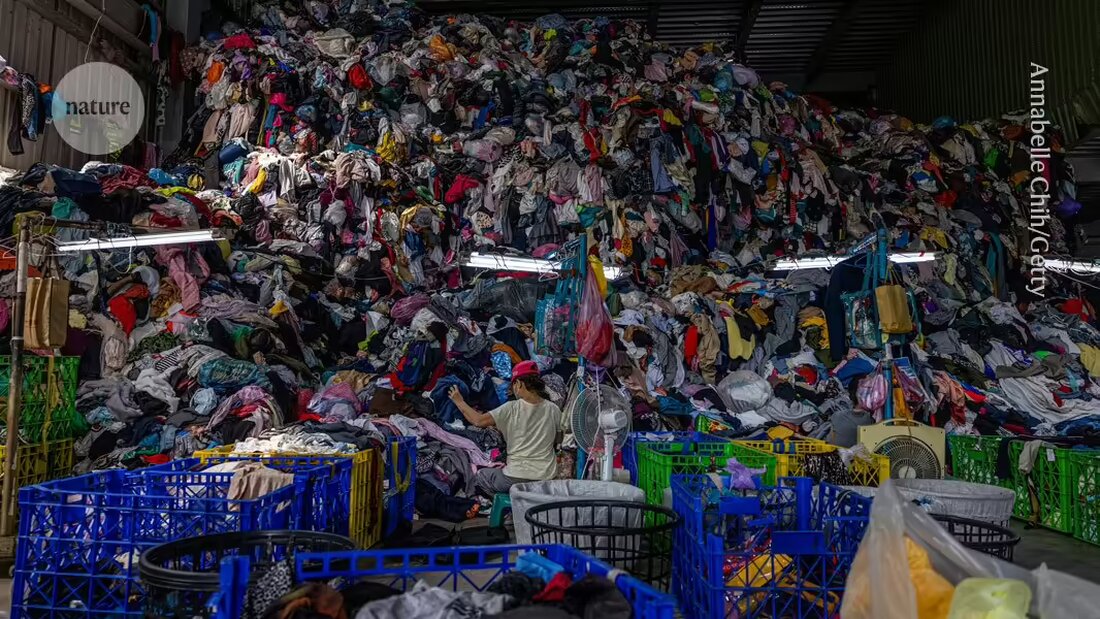Researchers have developed a chemical processing technique that can break down tissues into reusable molecules, even if they contain a mixture of materials.
The one in oneScience AdvancesThe process described in the July 3 paper shows that chemical recycling can breathe new life into old textiles. If scaled up, this could help address the rising mountain of waste generated by the fashion industry, says study co-author Dionisios Vlachos, an engineer at the University of Delaware in Newark.
Estimates suggest that less than 1% of textiles are recycled, and almost three quarters of used clothing ends up incinerated or in landfills. “A good third or more of the microplastics that end up in the ocean come from clothing,” says Vlachos. “Our ability to develop technology to deal with all this waste and remove it from the environment, landfills and oceans is very important.”
Miriam Ribul, who researches sustainable materials at the UKRI Textiles Circularity Centre, says that although recycling should be seen as a last resort after old clothing has been repaired and reused, the industry would “welcome investment in these new processes and technologies to scale up”.
Difficult textiles
Much recycling involves physically separating waste into raw materials, but this approach has weaknesses when processing textiles. Many fabrics are made from a mix of materials, for example cotton mixed with synthetic fibers such as polyester. Mechanical recycling techniques have difficulty separating multifiber textiles into products that can be reused. “The quality of what you get is reduced,” says Vlachos.
Researchers instead turned to chemical recycling to break down some synthetic components of tissues into reusable building blocks. They used a chemical reaction called microwave-assisted glycolysis, which can break down large chains of molecules - polymers - into smaller units using heat and a catalyst. They have used this to process fabrics with various compositions including 100% polyester and 50/50 poly-cotton, which is made up of polyester and cotton.
For pure polyester fabrics, the reaction converted 90% of the polyester into a molecule called BHET, which can be directly recycled to make more polyester fabrics. The researchers found that the reaction did not affect the cotton, so with polyester-cotton fabrics it was possible to both break down the polyester and recover the cotton. Crucially, the team was able to optimize the reaction conditions so that the process only took 15 minutes, making it extremely cost-effective. "Typically these things take days to break down. So, going from days to a few minutes, I think this is an important innovation," Vlachos says. Finally he says, “I think we can actually leave in seconds.”
expansion
The study also examined how other material combinations respond to the reaction process. The results were good, even if the textiles contained unknown amounts of fibers such as cotton, polyester, nylon or spandex. Spandex broke down into a useful molecule called MDA, and nylon, like cotton, could be extracted intact. However, some polyester fabrics produced reduced amounts of BHET, including dyed fabrics and those treated to resist UV light or fire. The team suggests that further research is needed to optimize conditions for such materials.
In an analysis as part of their study, Vlachos and his colleagues estimated that with further development, 88% of the world's clothing could be recycled.
“We have a simple process that we can scale to handle large volumes of clothing,” says Vlachos. “We are very optimistic that this can actually become a reality.”

 Suche
Suche
 Mein Konto
Mein Konto

